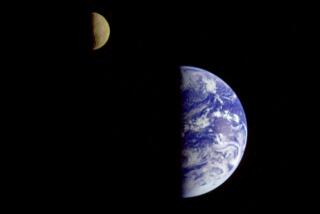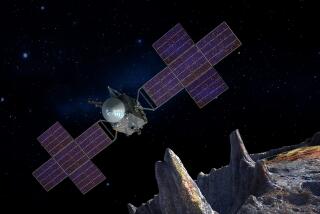Trojan asteroid tags along on Earth’s orbit
Turns out the moon’s not the Earth’s only traveling companion. Space scientists have discovered an asteroid that’s been following our fair planet for thousands of years, at least — and there may be many more where it came from, according to a recent study.
If other so-called Trojan asteroids are found, they could turn out to be ideal candidates for a visit from astronauts, something NASA hopes will be possible within the next 15 years.
Most of the asteroids in the solar system populate the belt of rocky debris between Mars and Jupiter. But planets can pull asteroids into their orbits, too. More than 4,000 Trojan asteroids have been discovered around the gas giant Jupiter, along with a few around Neptune and Mars.
But no such asteroid had ever been found near Earth. That led some scientists to believe that our planet lacked an entourage.
But others proposed a different explanation: Perhaps there were Trojan asteroids in Earth’s orbit around the sun, but they were simply hidden from view.
The problem was this: In order for an asteroid to attain a stable position in a planet’s orbit, it must find the spot where the gravitational pull of the planet and that of the sun cancel each other out. Two of these spots, called Lagrangian points, lie along a planet’s orbit — one ahead of the planet and one behind it. Drawing straight lines between the Earth, the sun and a Lagrangian point produces a triangle whose sides are equal in length. An asteroid there would hover in the sky at a 60-degree angle from the sun.
Any object that close to the sun would be difficult to see from Earth because it would be overhead mostly during broad daylight, as invisible as the stars.
But Martin Connors, a space scientist at Athabasca University in Alberta, Canada, had an idea. Maybe NASA’s Wide-Field Infrared Survey Explorer, which aims its lens 90 degrees away from the sun, would be able to pick up an oddball Trojan with an eccentric orbit.
Indeed it did. Connors found one candidate whose strange path over six days in late 2010 seemed to match the unevenly elongated orbit typical of Trojans. His team confirmed the Trojan’s identity by spotting it a few months later with another telescope in Hawaii.
“This is pretty cool,” said Amy Mainzer, a scientist at the Jet Propulsion Laboratory who wasn’t involved in the study, which was published online Wednesday by the journal Nature. “It’s a new class of near-Earth object that’s been hypothesized to exist.”
And if more Trojan asteroids can be found, researchers said, they could be ideal for astronaut visits and the mining of precious resources. (This particular asteroid is too tilted with respect to the solar system to make a good candidate, Mainzer said.)
Stuffed into a forgotten closet in the sky, such relics could also give scientists a fresh glimpse into the early formation of the solar system.
More to Read
Sign up for Essential California
The most important California stories and recommendations in your inbox every morning.
You may occasionally receive promotional content from the Los Angeles Times.











